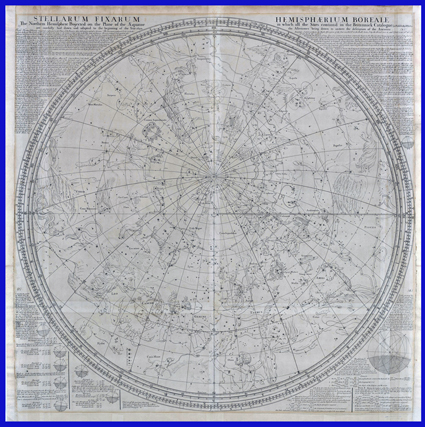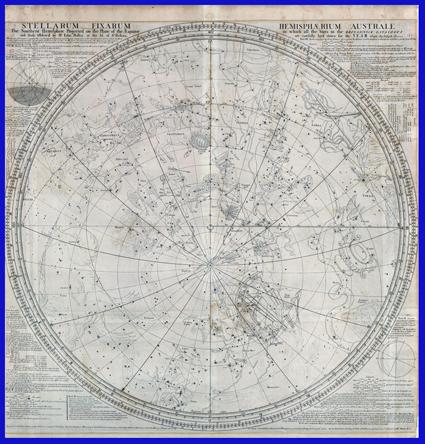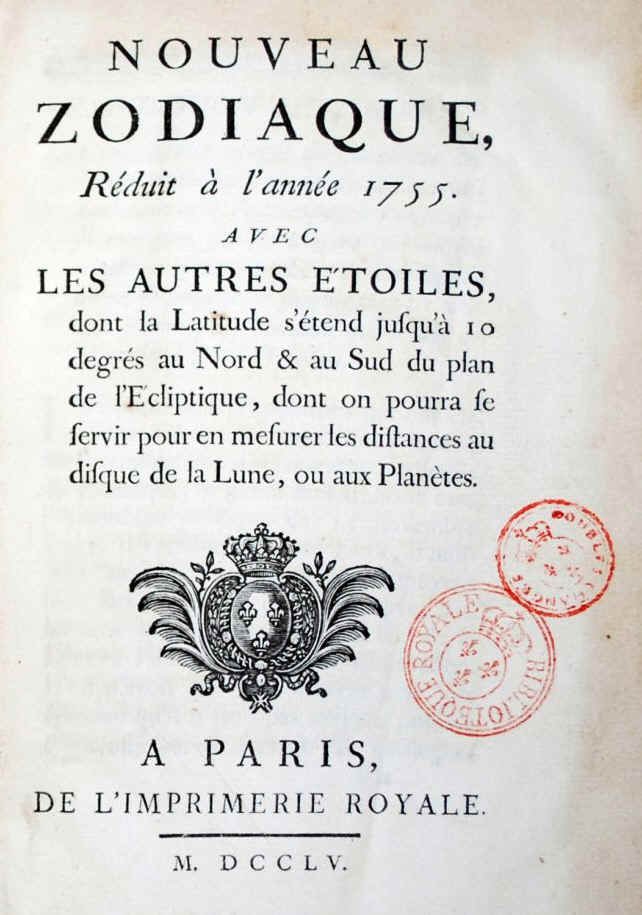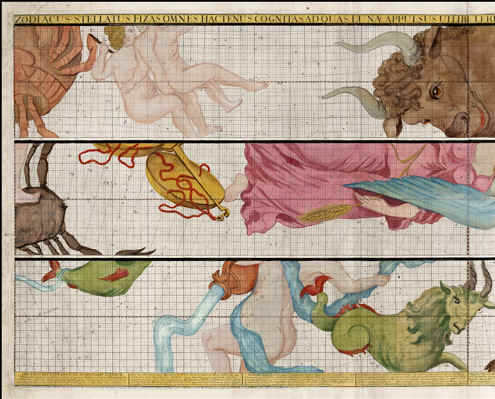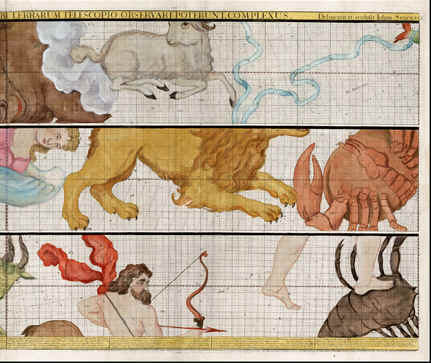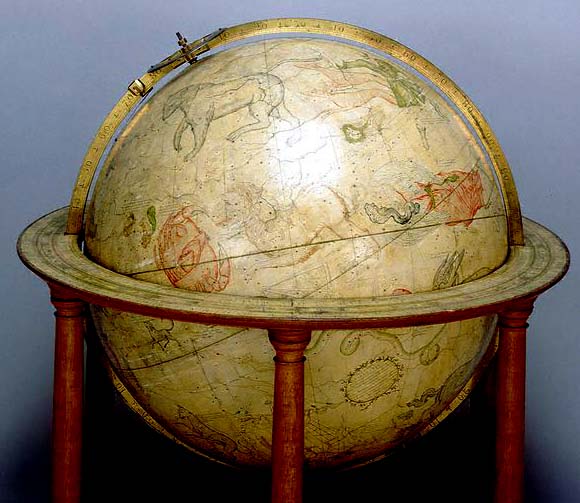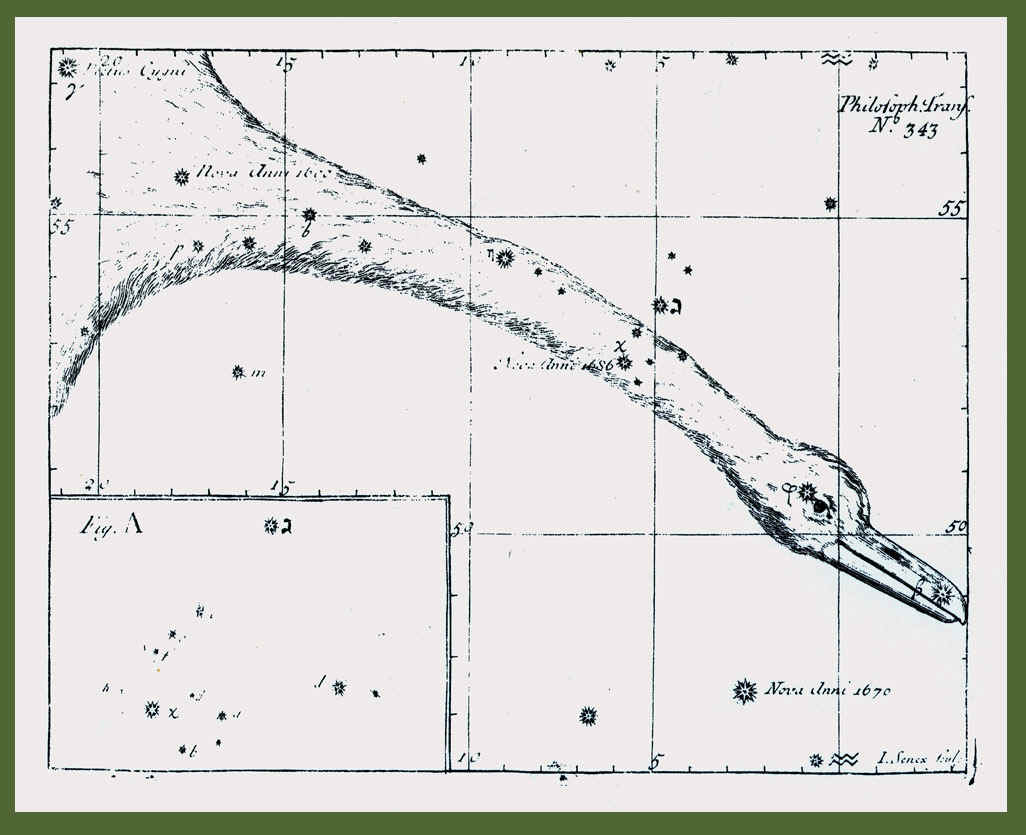|
John
Senex Zodiacus Stellatus Fixas Omnes Hactenus Cognitas, Ad Quas Lunae Appulsus Ullibi Terrarum Telescopio Observari Poterunt, Complexus. Deliniavit
et sculpsit Iohan: Senex R.S.S. La tavola, una delle rare copie colorate a mano
esistenti, viene pubblicata per cortesia di che attualmente la propone in vendita dal suo sito descrivendola con la presentazione seguente: Description: First
edition of this 3 sheet chart of the Zodiac, published by John Senex in John
Senex was one of the first English publishers to produce celestial charts.
As noted by Kanas, In part through his collaboration with Halley, Senex produced a number of
celestial maps . . . which were quite popular with astronomers and
navigators. . . One of these maps was originally
published in 1718 and showed the zodiac constellations in three long
strips arranged vertically over two pages on a map labeled Zodiacus
Stellatus Fixas Omnes Hactenus Cognitas . . . Each srip was centered
8 degrees above and below the ecliptic using a cylindrical projection with
geocentric orientation. . . Since the stars were derived
from Halley's unauthorized edition of Flamsteed's catalog, [Flamsteed
having refused to publish his work during his lifetime] . . . , the
appearance of this and other maps by Senex created great consternation at Senex's
work would remain the only representation of the constellations of the
Zodiac until Pierre Charles Le Monnier's work of 1755. The
map includes a fantastic description legend at the bottom, which begins as
follows: The DESCRIPTION and USE of the Starry ZODIAK. Finding that nothing
would more conduce toencourage Persons to ye Study of Astronomy than to
remove those difficulties which commonly deterr BEginners; and haveing by
ye favour of a Person of Quality, procured a Copy of the Britannick
Catalogue of Fixt Stars, I was persuaded ye I shold do the Science a
considerable piece of service, if I represented to a competent scale and
in their true Sitauation and Magnitude, all those Starrs to whic the Moon
or Planetts can at any time make their Appulses. For by this means
those that are provided with a Telescope only may be able to Judge of ye
accuracy of our Astronomical Tables & Ephemerides; and by ye farther
help of yes Micrometer & Pendulum Clock, may make such Observations as
may be of use to compleat ye Theory of ye Celestial Motions; ye
opportunitys of Observing being readily had by ye help of ye Zodiack. The British Catalogue ye being adopted to ye beginning of ye year 1600, I
was advised to follow it without reducing it to ye present Time; because
it would always be necessary to allow for ye increase of ye Starrs
Longitude in succeding Years, and it is no more work to subtract 30 or 40
then 15 or 20; This reduction being easily made, by subtracting 15 min:
for every 18 years lapsed since 1690, from ye place of ye Moon or Planet
found in te Ephemerides, when you would compare them with ye Starrs places
in the Zodiack. That ye Planets might be transferrd with more certainty into it I have drawn ye lines drawing each Degree both of Longitude and Latitude into quarters sufficiently distinguished from ye entire Degrees by ye smallness of ye stroaks for which reason there will be no need to use Compasses. Our Scale being so large as to afford a 10th of an Inch to each quarter of a Degree. Thus for Example if you desire to see how ye 3 Superiour Planets are situated among ye fixt Starrs ye 12st of April 1718; We find by ye Ephemerides of Mr. G. Parker for which are computed from Astronomia Carolina with sufficient care ye Saturn . . .
Confronta con John
Senex, Edmund Halley Stellarum
Fixarum Hemisphaerium Boreale, the Northern Hemisphere Projected on the
Plane of the AEquator in which all the Stars contain'd in the Britannick
Catalogue (as Publish'd by Dr. Halley) are carefully laid down and adapted
to the beginning of the year 1690. The Asterismes being drawn to answer
the description of the Ancients.
Stellarum
Fixarum Hemisphaerium Australe, The Southern Hemisphere Projected on the
Plane of the AEquator in which all the Stars
in the Britannick Catalogue
and those Observ'd
by Dr. Edm. Halley at the Isl. of St. Helena, are carefully layd down for
the Year
1690 by Joseph Harris.
London
1721-1728
Confronta con Guillaume Dheulland Table de la Longitude et de la Latitude De toutes les Etoilles fixes Zodiacales Suivant les Observations de Mr Flamsteed et le Catalogue Britannique ou l’on donne pour le Commencement de l’Année mil sept cent cinquante cinq, celles que la Lune et les autres Planètes peuvent Eclipser ou approcher… par G. DHEULLAND, Dessinateur et Graveur de sa Majesté pour la Marine. Paris, post 1755 in Pierre-Charles Le Monnier Nouveau Zodiaque, Réduit à l'année 1755. Avec les autres étoiles dont la latitude s'étend jusqu'à 10 degrés au Nord & au sud du plan de l’Ecliptique, dont on pourra se servir pour en mesurer les distances au disque de la Lune, ou aux Planètes. Paris 1755 e Versailles 1773
http://www.atlascoelestis.com/Le%20Monnier%201755.htm
Leggi anche Edmond Halley The Right Ascensions and Declinations of the Principal Fixed Starrs in both Hemisphears to ye year 1678, London 1678
http://www.atlascoelestis.com/Halley%20Right%20Ascension%201678.htm
|
LA TAVOLA Clicca sulle immagini per gli approfondimenti
IL PRIMO FOGLIO
IL SECONDO FOGLIO
La tavola, di formato 127,5x53,8 cm, pubblicata a Londra nel 1718, riporta, in proiezione cilindrica e in visione geocentrica, le stelle suddivise in sei classi di magnitudine poste a nord ed a sud dell'eclittica per una escursione di 8° di latitudine. La posizione delle stelle, identificate con il metodo introdotto da Bayer con lettere dell'alfabeto greco, è calcolata per il 1690. Essendo la proiezione cilindrica la scala della carta è di mezzo pollice ogni 15' di arco. Le costellazioni riportate, essendo quelle dello zodiaco, sono soltanto quelle tolemaiche e sono disegnate, su due fogli, in tre fasce. Ogni segno zodiacale vi viene presentato in un rettangolo che misura 12 pollici in larghezza per 6,25 in altezza. Sono sovrapposti due reticoli di riferimento, quello equatoriale con linee ogni 1° di declinazione ed ascensione retta, quello eclittico con linee ogni 15' di longitudine e latitudine. Anche
questa tavola, come tutte le altre di produzione di J. Senex ,hanno come
riferimento il catalogo stellare pubblicato da Halley nel 1712 che
riportava oltre a propri dati anche quelli ricavati dalle osservazioni
dell'astronomo reale Flamsteed che li aveva concessi per l'uso ma non per
la pubblicazione.
Celestial globe, circa 1730, London da http://www.cyclopaedia.org/senex/senexcelestial.html
De varia apparentia Stellae novae in Collo Cygni Narratio
MAGGIO 2013 di FELICE STOPPA
|

